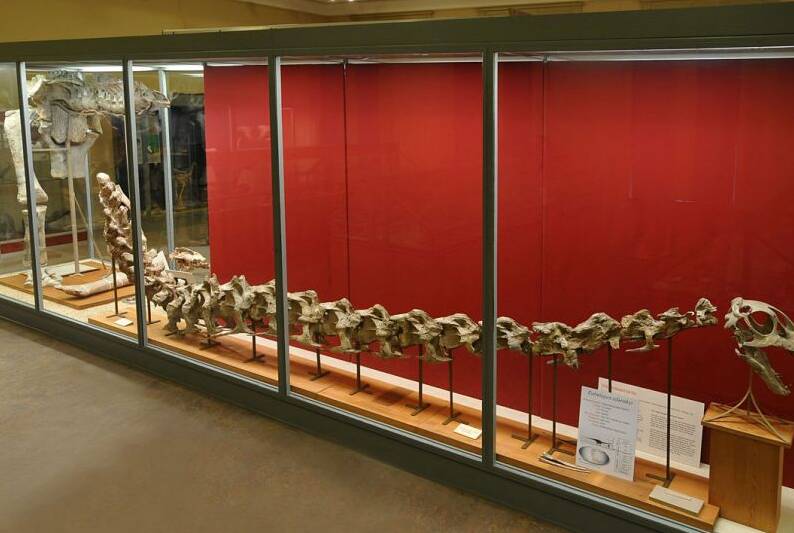You may all know about dinosaurs, but I believe you don’t have much specific understanding of them. Let us learn more about them through some dinosaur fossils.

1. Heilongjiang Manchurian dragon
China's first dragon
Heilongjiang Manchusaurus was discovered in Jiayin, Heilongjiang Province in 1902 and is known as "China's first dragon". Later, the fossil was transported to Russia and named Heilongjiang Manchusaurus in 1930. The holotype fossil of Heilongjiang Manchusaurus is now in the Geological Museum in St. Petersburg, Russia.

2. Shishi's Pan-footed Dragon
China's first sauropod dinosaur
Discopodosaurus was discovered in Mengyin, Shandong Province from 1922 to 1923 by Austrian Steinski and Chinese geologist Tan Xichou. The fossil was transported to Uppsala University in Sweden and named Discopodus in 1929. Piedosaurus is the first sauropod dinosaur in China.

3. Xu's Lufenglong
one of the oldest dinosaurs
Lufengosaurus xu is a genus of prosauropod dinosaur that lived in southwestern China during the early to middle Jurassic period. The fossil specimen was found in Lufeng, Yunnan Province, China. Lufengosaurus xu is one of the oldest dinosaurs discovered in China. Lufengosaurus Xu is China's first mounted dinosaur fossil (mounted and exhibited in Beibei, Chongqing in 1941). It was researched and named in 1941 by Academician Yang Zhongjian, the founder of Chinese vertebrate paleontology. It is the founder of the China Paleontology Museum. The treasure of the town hall.

4. Spiny-nosed Qingdao dragon
Crested duck-billed dinosaur fossil
Spiny-nosed Qingdaosaurus is the most famous crested duck-billed dinosaur fossil discovered in my country, and is also the first complete dinosaur fossil discovered in my country. The existing specimens are preserved in the China Museum of Paleontology. Because it was found in Xigou, Jingangkou Village, Laiyang City, near Qingdao, and has a spiny nose-shaped crest on its head, it got its name. The strata where the spinous-nosed Qingdaosaurus fossils are located date from the late Cretaceous period.

5. Hechuan Mamenchisaurus
The first dinosaur fossil discovered after the founding of New China
One of the largest sauropod dinosaurs discovered in China, its fossil was found at the Maming River Ferry in Yibin City. It has been scientifically identified as belonging to the order "Sauropod Equus". This animal has a total length of about 22 meters and a body height of nearly 7 meters. It The neck is extremely long, equivalent to half the body length. Not only is each cervical vertebra that makes up the neck long, but the number of cervical vertebrae is as many as 19, which is the most among sauropods. In addition, the neck is also the longest among all dinosaurs. (the longest neck can reach 12.1 meters). Compared with the cervical vertebrae, there are relatively few dorsal vertebrae, sacral vertebrae and coccygeal vertebrae.

6. Giant Shandong Dragon
Dinosaur that walked upright on two legs
Shantungosaurus giganteus is a species of ornithopod dinosaur, Hadrosauridae, and genus Shantungosaurus. It is herbivorous, 8 meters high and 15 meters long, with a flat head and no crest. It is the representative of the flat-headed duck-billed dinosaur. Lived in the late Cretaceous period of the Mesozoic Era. The fossil specimen was found in Shandong Province, China.

7. Taibai Huayang Dragon
The world’s most primitive and best-preserved Stegosaurus discovered
Taibai Huayangosaurus is a medium-sized primitive stegosaurus with a body length of 4.3 meters. Its main characteristics are a large and thick head, triangular shape, a short neck, and its forelimbs are much shorter than its hind legs, but it walks on all fours. The two rows of bony plates on the back are relatively small and changeable in shape, and there are two pairs of plate-like tail spines at the tail end. Existing specimens are displayed in the Zigong Dinosaur Museum and Chongqing Museum.

8. Microraptor Gu's
The first known flying dinosaurs
The holotype specimen of Microraptor Gu's is only about 77 centimeters in length, and its diet is carnivorous. The trunk is relatively short, only 44% to 50% of the length of the hind limbs, and the tail is longer than the body; its radius bone has a prominent biceps tubercle, the first finger of the forelimb is very short, a single sternum is flat and large, and the pubic bone is strongly curved. The tibial arch can distinguish it from Microraptor zhao.
animal tags: Dinosaurs fossils Manchusaurus Discopodosaurus Lufengsaurus Stegosaurus
We created this article in conjunction with AI technology, then made sure it was fact-checked and edited by a Animals Top editor.